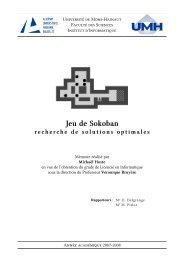Acyclic Joins
Acyclic Joins
Acyclic Joins
Create successful ePaper yourself
Turn your PDF publications into a flip-book with our unique Google optimized e-Paper software.
2 Preliminaries<br />
We assume relation names R, S, R 1 , S 1 , R 2 , S 2 , . . . . Each relation name R is associated with a finite set of<br />
attributes, denoted sort(R). Letters A, B, C, . . . denote attributes. We will write R[X] to denote that R is a<br />
relation name with sort(R) = X.<br />
A schema S is a finite set of relation names such that for all R 1 , R 2 ∈ S, if R 1 ≠ R 2 , then sort(R 1 ) ≠<br />
sort(R 2 ). Thus, we require that no two distinct relation names are associated with the same set of attributes.<br />
This restriction is not fundamental, but simplifies the technical treatment: an element R[X] of a schema is<br />
uniquely identified by X.<br />
A database over a schema S associates to each relation name R ∈ S a relation over sort(R).<br />
Whenever a database is fixed, we do not distinguish between the relation name R and the relation associated<br />
with R. For example, when we talk about the “join of R and S,” we mean the join of the relations associated<br />
with R and S.<br />
Also, we will use R as a shorthand for sort(R). For example, we will write π R (R ✶ S) instead of π sort(R) (R ✶ S).<br />
3 Semijoin<br />
Recall that sort(R ✶ S) := sort(R) ∪ sort(S) and R ✶ S := {t | t[R] ∈ R and t[S] ∈ S}. The operator ✶<br />
is commutative and associative.<br />
The semijoin of R and S, denoted R ⋉ S, is the subset of R containing each tuple of R that joins with<br />
some tuple of S. Formally, R ⋉ S := π R (R ✶ S). A tuple of R that does not belong to R ⋉ S is called<br />
dangling.<br />
Exercise 1 Show that R ⋉ S = R ✶ π R∩S (S).<br />
Assume that R and S reside on different sites, and that we want to compute R⋉S. The amount of transmitted<br />
data must be minimized. We can ship S to the site of R. However, the expression of Exercise 1 tells us that<br />
it is sufficient to ship π R∩S (S) to the site of R.<br />
4 Joining Two Relations Residing at Different Sites<br />
Show the following.<br />
R ✶ S = (R ⋉ S) ✶ S (1)<br />
= (S ⋉ R) ✶ R (2)<br />
Assume that R and S reside on different sites, and that we want to compute R ✶ S. Equation (1) tells us<br />
that we can compute R ⋉ S as in Section 3, and ship the result to the site of S. In this way, we avoid the<br />
transmission of dangling tuples of R. In summary [1, p. 701],<br />
1. Compute π R∩S (S) at the site of S.<br />
2. Ship π R∩S (S) to the site of R.<br />
3. Compute R ⋉ S at the site of R, using the fact that R ⋉ S = R ✶ π R∩S (S).<br />
4. Ship R ⋉ S to the site of S.<br />
5. Compute R ✶ S at the site of S, using the fact that R ✶ S = (R ⋉ S) ✶ S.<br />
There is a symmetric strategy, with R and S interchanged.<br />
2



